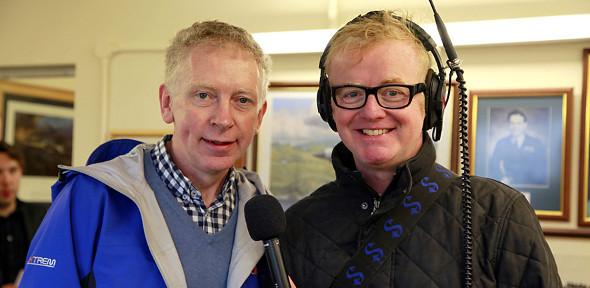
As the country commemorated the 70th anniversary of the daring Dambusters raid of World War II, Dr Hugh Hunt found himself interviewed on both radio and television.
The interview itself was so easy because Chris Evans was well prepared and had really good questions to ask. It was like talking with a friend.
Dr Hugh Hunt
A senior lecturer in the Department of Engineering, Hugh's expertise and knowledge of the engineering complexity of the remarkable raid, which took place on the night of 16/17 May 1943, made him an ideal guest on a number of radio and television shows - most notably the Chris Evans Radio 2 Breakfast Show and the BBC 1 The One Show.
As a guest on Radio 2, Hugh had to travel to RAF Scampton in Lincolnshire where Chris Evans was broadcasting his show.
Hugh said: "I met Chris Evans about 30 seconds before going on air. The music stopped and he started talking about our documentary and then he asked me a question. He stands very close! He pushed the microphone up to my face and I had to lean back - so the microphone came even closer. It was very intimate.
"The interview itself was so easy because Chris was well prepared and had really good questions to ask. It was like talking with a friend. It was all great fun.
"Later the same day, after coming back to Cambridge, I travelled down to the BBC studios in White City for The One Show. Alex Jones introduced herself and then said "you know Chris" as if we were old friends. We rehearsed for about 2 minutes and then at 7pm the show began. We had prepared a bouncing tennis ball machine outside in the water feature and I was busy working out how the machine worked. Then up to the make up room and then into the Green Room to wait. Suddenly I was called in to the sofa - it all just happened and it was very easy."
Hugh led the Cambridge team which recreated the famous bouncing bomb for the award-winning 2011 Channel 4 documentary, Dambusters: Building The Bouncing Bomb.
Later immortalised in the 1955 film, The Dam Busters, the raid sent Lancaster bombers to fly dangerously low over reservoirs in the strategically important Ruhr Valley. Under intense anti-aircraft fire, the crews dropped "bouncing" bombs, specially designed by the British engineer, Sir Barnes Neville Wallis. While the mission itself has gone down as one of the most iconic episodes in Britain's wartime story, few details about how the bouncing bomb was built remain as most of Barnes Wallis' original calculations, designs and results were lost.
For the documentary, Hugh was the lead engineer designing simulated bouncing 'bombs' that were constructed from scratch, then dropped by aircraft flying just 60 feet above the surface of a lake in British Columbia, Canada, to destroy a 130-feet wide dam. It was the first time that this had been attempted since the war. Hugh was assisted by dam engineers, explosives experts, mechanics and pilots who specialise in low altitude flying.
Of the 133 hand-picked air-crew in 1943, which comprised pilots of many nationalities, including members of the Canadian, Australian and New Zealand air forces, 53 lost their lives in the original Dambusters raid.
"Our pilots had no-one shooting at them, the engineers could use things like bowling machines to test their theories, and the whole thing was only at one third scale - and even then it was hard enough," commented Hugh. "You compare that with the original challenge - for Barnes Wallis and for the pilots - and you realise what an amazing achievement it was."

